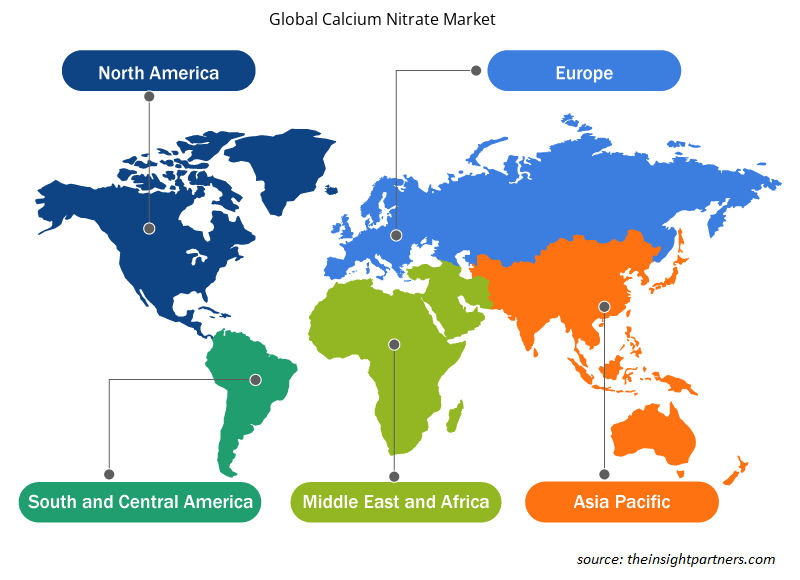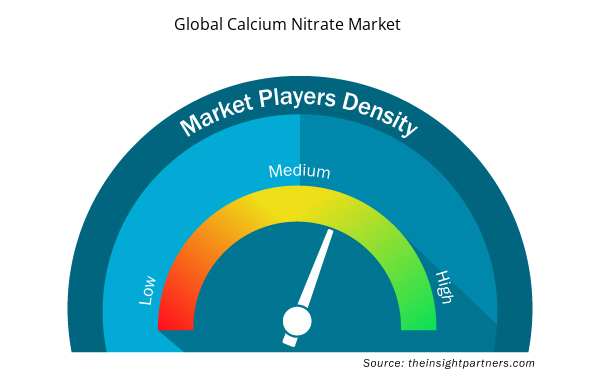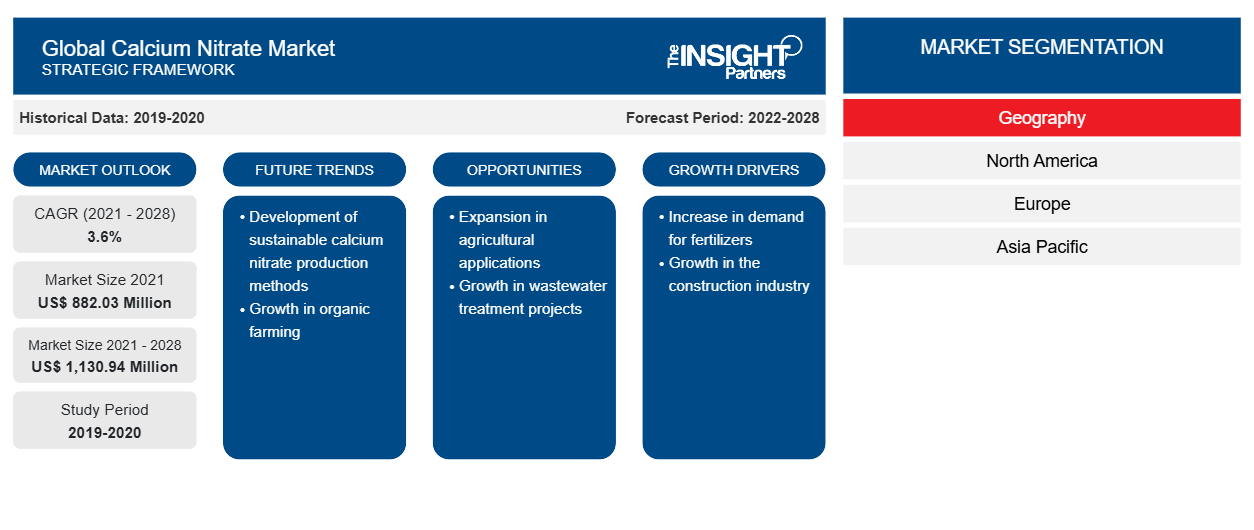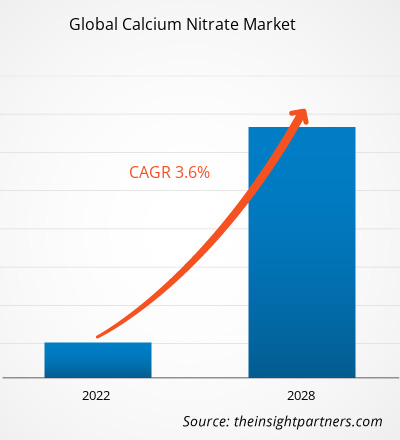[研究报告] 2021 年硝酸钙市场价值为 8.8203 亿美元,预计到 2028 年将达到 11.3094 亿美元;预计 2021 年至 2028 年的复合年增长率为 3.6%。
市场分析
硝酸钙是一种有机化合物,由硝酸处理石灰石并用氨中和而成。硝酸钙主要用作肥料成分。硝酸钙肥料含有钙和氮,它们是植物必需的营养元素。它能增强土壤中镁、钾和钙的吸收,提高产量和质量,延长水果的保鲜期,增强对疾病和害虫的抵抗力。硝酸钙还用于制造混凝土、炸药和废水处理的药用目的。此外,它还被积极用于抑制下水道网络和市政废水处理中的臭味形成。
增长动力与挑战
肥料制造商对硝酸钙的需求不断增长,这极大地推动了全球硝酸钙市场的增长。农业是全球经济的重要组成部分。农业是就业、收入和粮食的主要来源,它满足了全世界的这些基本需求。根据粮食及农业组织 (FAO) 的数据,农业人口占总人口的 67%。中国拥有世界 7% 的可耕地,可以养活世界 22% 的人口。随着农业人口的发展,对硝酸钙的需求也在增长。此外,硝酸钙在广泛应用中的使用增加进一步推动了全球硝酸钙市场的增长。硝酸钙以颗粒形式生产,主要用作农业中的氮肥。钙对植物有许多重要的好处。它可以提高细胞壁强度,从而生产出质量更高、保质期更长的水果。钙还可以提高耐热性,有助于减少植物在温暖气候下所经受的热应激。它还用于防臭废水预处理和促凝混凝土外加剂。在废水处理过程中,该化合物诱导废水处理中的缺氧生物,抑制产生臭味成分(如硫化氢)的代谢生成,从而消除恶臭。它还能诱导自养反硝化,有助于化粪池废水中硫化物的生物溶解。然而,替代品的可用性可能会限制其市场增长有机肥料和非有机肥料是两大类肥料。硝酸钙是一种无机化学物质,分子式为 Ca(NO3)2,主要用于肥料。硝酸钙肥料提供植物所需的重要营养,同时还能提高土壤的保水能力和肥力。它可以通过灌溉水施用于土壤,也可以通过叶面处理施用于土壤。
定制此报告以满足您的需求
您可以免费定制任何报告,包括本报告的部分内容、国家级分析、Excel 数据包,以及为初创企业和大学提供优惠和折扣
- 获取此报告的关键市场趋势。这个免费样品将包括数据分析,从市场趋势到估计和预测。
报告分类和范围
“2030 年全球硝酸钙市场分析”是一项专业而深入的研究,主要关注全球硝酸钙市场趋势和增长机会。该报告旨在概述全球硝酸钙市场,并按应用和地域对市场进行详细细分。全球硝酸钙市场近年来一直保持高增长,预计在预测期内将继续保持这一趋势。该报告提供了全球硝酸钙消费量的关键统计数据以及主要地区和国家的需求。此外,该报告还对影响主要地区和国家硝酸钙市场表现的各种因素进行了定性评估。该报告还包括对硝酸钙市场主要参与者及其关键战略发展的全面分析。还包括对市场动态的几项分析,以帮助确定关键驱动因素、市场趋势和有利可图的硝酸钙市场机会,进而有助于确定主要收入来源。
此外,生态系统分析和波特五力分析提供了全球硝酸钙市场的360度视角,有助于了解整个供应链和影响市场增长的各种因素。
节段分析
全球硝酸钙市场根据其应用进行细分。根据应用,市场分为肥料、废水处理化学品、混凝土制造、炸药等。根据应用,肥料部分占据了硝酸钙市场的主要份额,这可以归因于硝酸钙在各种应用中的使用增加。硝酸钙是一种复杂的水溶性肥料,其中 15.5% 为易获取形式的氮 (N),18.5% 为钙 (Ca)。钙是作物生产所需的次要营养素之一。它有助于改善果实的颜色、光泽和稠度;土壤结构和水分渗透;以及作物的抗虫和抗病能力。硝酸钙肥料是植物唯一可用的水溶性钙源。它既可以用作肥料,也可以用作疾病防治剂。该化合物有助于稳定细胞生长,并通过促进细胞形成来促进蛋白质和叶子的生产。它还通过中和酸来帮助植物解毒。这将进一步为整个行业增长吸引新的增长机会。
区域分析
报告详细介绍了全球硝酸钙市场,涉及五个主要地区,即北美、欧洲、亚太地区 (APAC)、中东和非洲 (MEA) 以及南美和中美。中东和非洲占据了相当大的市场份额,2022 年价值超过 3500 万至 4000 万美元,预计到 2030 年将达到 4000 万至 4500 万美元。农业活动的快速增长,尤其是中东地区的农业活动,为中东和非洲市场的增长做出了积极贡献。亚太地区也见证了 2022 年价值超过 13 亿至 14 亿美元的可观增长,这归因于该地区硝酸钙在各种应用中的使用增加,推动了全球硝酸钙市场的增长。北美预计也将见证 2022 年价值超过 2.5 亿至 3 亿美元的可观增长,这归因于农业行业中硝酸钙使用量的增加,预计将推动全球硝酸钙市场的增长。
行业发展和未来机遇
合作、收购和新产品推出被发现是全球硝酸钙市场参与者所采用的主要策略。
- 2022 年 8 月,俄罗斯矿物肥料生产商阿康集团在其大诺夫哥罗德工厂投入使用年产 100,000 吨的颗粒硝酸钙生产装置。
- 2021年4月,FB Science又增加了三种产品,完善了其六种硝酸钙产品线。
硝酸钙市场报告范围
全球硝酸钙市场区域洞察
Insight Partners 的分析师已详细解释了预测期内影响全球硝酸钙市场的区域趋势和因素。本节还讨论了全球硝酸钙市场在北美、欧洲、亚太地区、中东和非洲以及南美和中美的细分市场和地理位置。

- 获取全球硝酸钙市场的区域特定数据
全球硝酸钙市场报告范围
| 报告属性 | 细节 |
|---|---|
| 2021 年市场规模 | 8.8203亿美元 |
| 2028 年市场规模 | 11.3094亿美元 |
| 全球复合年增长率(2021 - 2028) | 3.6% |
| 史料 | 2019-2020 |
| 预测期 | 2022-2028 |
| 覆盖地区和国家 | 北美
|
| 市场领导者和主要公司简介 |
|
市场参与者密度:了解其对商业动态的影响
全球硝酸钙市场正在快速增长,这得益于终端用户需求的不断增长,而这些需求又源于消费者偏好的不断变化、技术进步以及对产品优势的认识不断提高等因素。随着需求的增加,企业正在扩大其产品范围,进行创新以满足消费者的需求,并利用新兴趋势,从而进一步推动市场增长。
市场参与者密度是指在特定市场或行业内运营的企业或公司的分布情况。它表明在给定市场空间中,相对于其规模或总市场价值,有多少竞争对手(市场参与者)存在。
在全球硝酸钙市场运营的主要公司有:
- 营养素
- 雅苒国际
- 斯特林化学公司
- Gfs 化学品有限公司
- 海法集团
免责声明:上面列出的公司没有按照任何特定顺序排列。

- 了解全球硝酸钙市场主要参与者概况
新冠疫情的影响/地缘政治形势的影响/经济衰退的影响
COVID-19 疫情导致全球许多行业的发展放缓。全球制造工厂的关闭和贸易限制导致全球制造商的供应链受限。持续的疫情彻底改变了化学品和材料行业的现状,并对硝酸钙市场的增长产生了负面影响。为防止病毒传播而采取的措施加剧了形势,影响了多个工业部门的增长。由于硝酸钙生产放缓、供应链不稳定、贸易流动受阻、终端使用行业需求下降以及新项目需求减少,市场正受到 COVID-19 的干扰。由于国内和国际边界突然关闭,疫情扭曲了运营效率并扰乱了价值链,造成收入损失和损害。价值链中断对原材料供应产生了负面影响。因此,硝酸钙市场已从疫情后恢复得相当好,预计未来几年将实现增长。
竞争格局和主要公司
硝酸钙市场的一些主要参与者包括 Nutrien;Yara international ASA;Sterling Chemicals Company;GFS Chemicals, Inc.;Haifa Group;Uralchem holding PLC;Rural Liquid Fertilisers;山西交城天龙化工有限公司;ProChem, Inc;Van Iperen International 等。
- 历史分析(2 年)、基准年、预测(7 年)及复合年增长率
- PEST 和 SWOT 分析
- 市场规模价值/数量 - 全球、区域、国家
- 行业和竞争格局
- Excel 数据集



Report Coverage
Revenue forecast, Company Analysis, Industry landscape, Growth factors, and Trends

Segment Covered
This text is related
to segments covered.

Regional Scope
North America, Europe, Asia Pacific, Middle East & Africa, South & Central America

Country Scope
This text is related
to country scope.
常见问题
The major players operating in the global calcium nitrate market are Nutrien; Yara International Asa; Sterling Chemicals Company; Gfs Chemicals, Inc.; Haifa Group; Uralchem Holding Plc; Rural Liquid Fertilisers; Shanxi Jiaocheng Tianlong Chemical Industry Co., Ltd.; Prochem, Inc; and Van Iperen Internationalamong many others.
Calcium nitrate is widely used as a fertilizer as it helps enhance the uptake of magnesium, potassium, and calcium from the soil; improve the yield and quality of crop; extend the storage life of fruits; and build up resistance to diseases and pests. Further, calcium improves cell wall strength, which leads to higher-quality fruits with a longer shelf-life. It also increases heat tolerance and helps reduce the impact of heat stress experienced by plants in warmer climates. Such factors have increased the demand for calcium nitrate fertilizers in agriculture and it is expected to witness the highest growth within the forecast period.
Calcium nitrate is synthesized chemically by treating limestone with nitric acid, followed by neutralizing the outcome with ammonia. Calcium nitrate is produced in a granulated form and is mostly used as a nitrogen fertilizer in agriculture. The calcium nitrate-based fertilizers help enhance the uptake of magnesium, potassium, and calcium from the soil; improve the yield and quality of crop; extend the storage life of fruits; and build up resistance to diseases and pests. The calcium nitrate market has been segmented based on applications such as fertilizers, wastewater treatment chemicals, concrete manufacturing, explosives, and others.
Trends and growth analysis reports related to Chemicals and Materials : READ MORE..
The List of Companies - Global Calcium Nitrate Market
- Nutrien
- Yara International Asa
- Sterling Chemicals Company
- Gfs Chemicals, Inc.
- Haifa Group
- Uralchem Holding Plc
- Rural Liquid Fertilisers
- Shanxi Jiaocheng Tianlong Chemical Industry Co., Ltd.
- Prochem, Inc.
- Iperen International
The Insight Partners performs research in 4 major stages: Data Collection & Secondary Research, Primary Research, Data Analysis and Data Triangulation & Final Review.
- Data Collection and Secondary Research:
As a market research and consulting firm operating from a decade, we have published and advised several client across the globe. First step for any study will start with an assessment of currently available data and insights from existing reports. Further, historical and current market information is collected from Investor Presentations, Annual Reports, SEC Filings, etc., and other information related to company’s performance and market positioning are gathered from Paid Databases (Factiva, Hoovers, and Reuters) and various other publications available in public domain.
Several associations trade associates, technical forums, institutes, societies and organization are accessed to gain technical as well as market related insights through their publications such as research papers, blogs and press releases related to the studies are referred to get cues about the market. Further, white papers, journals, magazines, and other news articles published in last 3 years are scrutinized and analyzed to understand the current market trends.
- Primary Research:
The primarily interview analysis comprise of data obtained from industry participants interview and answers to survey questions gathered by in-house primary team.
For primary research, interviews are conducted with industry experts/CEOs/Marketing Managers/VPs/Subject Matter Experts from both demand and supply side to get a 360-degree view of the market. The primary team conducts several interviews based on the complexity of the markets to understand the various market trends and dynamics which makes research more credible and precise.
A typical research interview fulfils the following functions:
- Provides first-hand information on the market size, market trends, growth trends, competitive landscape, and outlook
- Validates and strengthens in-house secondary research findings
- Develops the analysis team’s expertise and market understanding
Primary research involves email interactions and telephone interviews for each market, category, segment, and sub-segment across geographies. The participants who typically take part in such a process include, but are not limited to:
- Industry participants: VPs, business development managers, market intelligence managers and national sales managers
- Outside experts: Valuation experts, research analysts and key opinion leaders specializing in the electronics and semiconductor industry.
Below is the breakup of our primary respondents by company, designation, and region:

Once we receive the confirmation from primary research sources or primary respondents, we finalize the base year market estimation and forecast the data as per the macroeconomic and microeconomic factors assessed during data collection.
- Data Analysis:
Once data is validated through both secondary as well as primary respondents, we finalize the market estimations by hypothesis formulation and factor analysis at regional and country level.
- Macro-Economic Factor Analysis:
We analyse macroeconomic indicators such the gross domestic product (GDP), increase in the demand for goods and services across industries, technological advancement, regional economic growth, governmental policies, the influence of COVID-19, PEST analysis, and other aspects. This analysis aids in setting benchmarks for various nations/regions and approximating market splits. Additionally, the general trend of the aforementioned components aid in determining the market's development possibilities.
- Country Level Data:
Various factors that are especially aligned to the country are taken into account to determine the market size for a certain area and country, including the presence of vendors, such as headquarters and offices, the country's GDP, demand patterns, and industry growth. To comprehend the market dynamics for the nation, a number of growth variables, inhibitors, application areas, and current market trends are researched. The aforementioned elements aid in determining the country's overall market's growth potential.
- Company Profile:
The “Table of Contents” is formulated by listing and analyzing more than 25 - 30 companies operating in the market ecosystem across geographies. However, we profile only 10 companies as a standard practice in our syndicate reports. These 10 companies comprise leading, emerging, and regional players. Nonetheless, our analysis is not restricted to the 10 listed companies, we also analyze other companies present in the market to develop a holistic view and understand the prevailing trends. The “Company Profiles” section in the report covers key facts, business description, products & services, financial information, SWOT analysis, and key developments. The financial information presented is extracted from the annual reports and official documents of the publicly listed companies. Upon collecting the information for the sections of respective companies, we verify them via various primary sources and then compile the data in respective company profiles. The company level information helps us in deriving the base number as well as in forecasting the market size.
- Developing Base Number:
Aggregation of sales statistics (2020-2022) and macro-economic factor, and other secondary and primary research insights are utilized to arrive at base number and related market shares for 2022. The data gaps are identified in this step and relevant market data is analyzed, collected from paid primary interviews or databases. On finalizing the base year market size, forecasts are developed on the basis of macro-economic, industry and market growth factors and company level analysis.
- Data Triangulation and Final Review:
The market findings and base year market size calculations are validated from supply as well as demand side. Demand side validations are based on macro-economic factor analysis and benchmarks for respective regions and countries. In case of supply side validations, revenues of major companies are estimated (in case not available) based on industry benchmark, approximate number of employees, product portfolio, and primary interviews revenues are gathered. Further revenue from target product/service segment is assessed to avoid overshooting of market statistics. In case of heavy deviations between supply and demand side values, all thes steps are repeated to achieve synchronization.
We follow an iterative model, wherein we share our research findings with Subject Matter Experts (SME’s) and Key Opinion Leaders (KOLs) until consensus view of the market is not formulated – this model negates any drastic deviation in the opinions of experts. Only validated and universally acceptable research findings are quoted in our reports.
We have important check points that we use to validate our research findings – which we call – data triangulation, where we validate the information, we generate from secondary sources with primary interviews and then we re-validate with our internal data bases and Subject matter experts. This comprehensive model enables us to deliver high quality, reliable data in shortest possible time.


 获取此报告的免费样本
获取此报告的免费样本